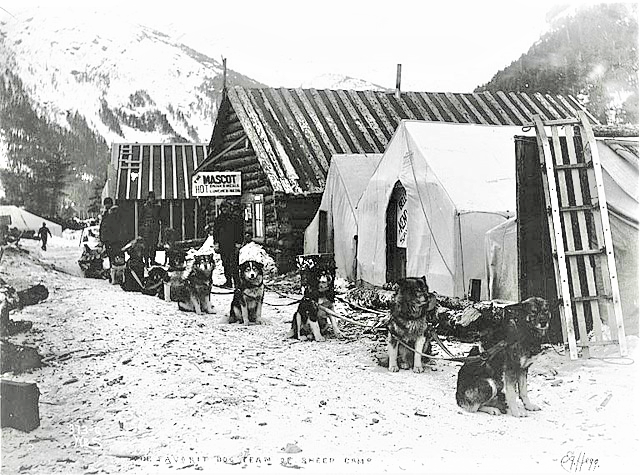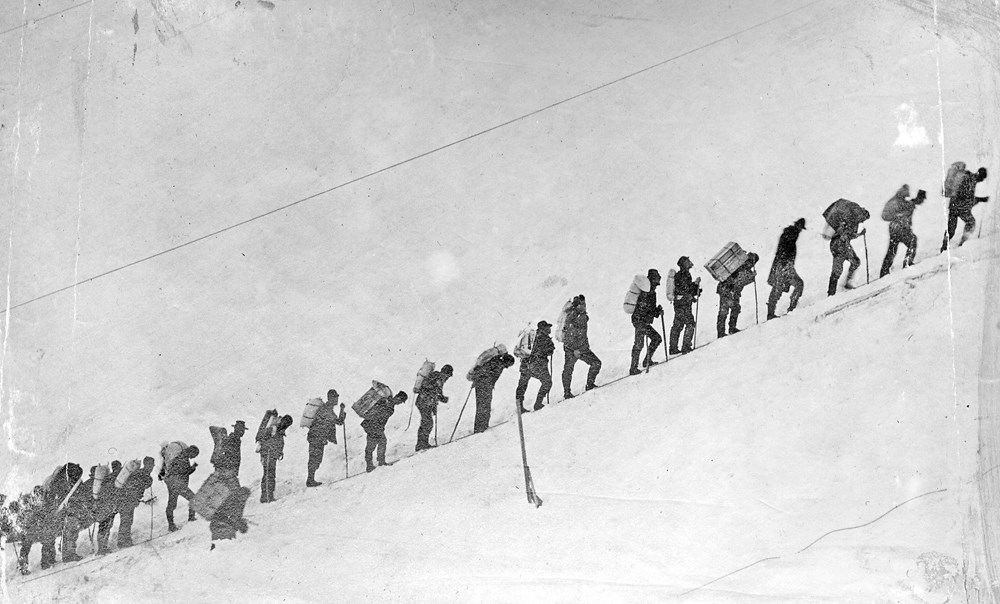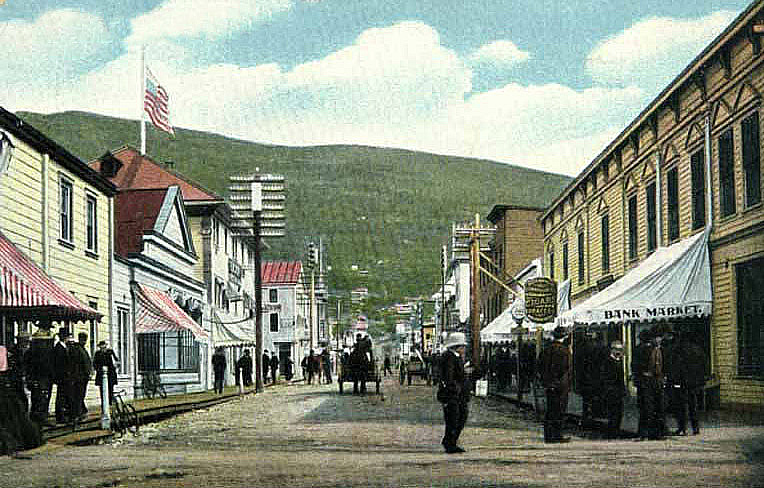The Klondike gold rush took place in the Yukon Territory of Canada when gold was discovered in the Klondike River in 1896, attracting an estimated 100,000 prospectors in hopes of striking it rich.
Contents
Part 1: Introduction to the Klondike Gold Rush

The Klondike Gold Rush was a significant event in history that attracted an estimated 100,000 prospectors to the Klondike region of Yukon, in north-western Canada (not Alaska/ USA), between 1896 and 1899. This mass migration was sparked by the discovery of gold in the region, leading to a rush of individuals hoping to strike it rich.
10 Facts about the Klondike Gold Rush
Here are some key facts about the Klondike Gold Rush:
- Discovery of Gold: Gold was discovered in Bonanza (Rabbit) Creek, a tributary of the Klondike River, in August 1896 by George Carmack, Skookum Jim Mason and Tagish Charlie.
- Scale of Migration: An estimated 100,000 prospectors migrated to the Klondike region of Yukon, Canada, between 1896 and 1899.
- The Golden Staircase: The Chilkoot Trail, one of the main routes to the Klondike, featured a steep climb known as the “Golden Staircase,” which prospectors, loaded down with supplies, had to ascend. The other popular route was the White Pass trail, also known as the “Dead Horse Trail”.
- Limited Success: Although around 100,000 people set off for the Klondike, only around 30,000 to 40,000 actually made it there. Out of these, it’s estimated that only around 4,000 found gold.
- Booming Towns: Dawson City, located near the discovery site, grew rapidly as the center of the Klondike Gold Rush, its population reaching 40,000 in 1898, comparable to the population of San Francisco at the time.
- End of the Rush: The Klondike Gold Rush essentially ended in 1899 when news reached the Klondike that gold had been discovered in Nome, Alaska, leading many prospectors to leave the Klondike.
- Klondike Gold Rush National Historical Park: Today, the routes used by prospectors, the Chilkoot and White Pass trails, form part of the Klondike Gold Rush National Historical Park, which commemorates the Gold Rush and its importance in history.
- Impact on Yukon and Alaska: The Klondike Gold Rush resulted in the creation of Yukon Territory as a separate Canadian province, and it significantly boosted the economy of Alaska.
- Cultural Impact: The Klondike Gold Rush inspired many stories, books, and films. Jack London’s famous novels “The Call of the Wild” and “White Fang” are set during the Klondike Gold Rush.
- “Klondike Kate” Rockwell: One of the more colorful figures of the Klondike Gold Rush was a dancer and vaudeville star known as “Klondike Kate” Rockwell. Her flamboyant performances made her a well-known figure during the Gold Rush.
Check out other articles about gold rushes on this website:
Table of Main Events of the Klondike Gold Rush
| Year | Event |
| 1896 | Gold is discovered in Rabbit Creek, a tributary of the Klondike River, igniting the Klondike Gold Rush. |
| 1897 | The news of the gold discovery reaches the United States, causing a large number of prospectors to head to the Klondike. |
| 1898 | The population of Dawson City reaches 40,000 as more prospectors arrive, despite the harsh winter conditions. |
| 1898 | The White Pass & Yukon Route railroad is built to facilitate transportation to the goldfields. |
| 1899 | The discovery of gold in Nome, Alaska, attracts many prospectors away from the Klondike, marking the beginning of the end of the Klondike Gold Rush. |
| 1900 | The Klondike Gold Rush officially ends, leaving a lasting impact on the history and identity of Yukon. |
On August 16, 1896, Skookum Jim, George Carmack, and Dawson Charlie, also known as the “Three Lucky Sourdoughs,” found gold near the Klondike River. Their discovery sparked one of the largest gold rushes in history. This event is often referred to as the Yukon Gold Rush due to its location. You can read more about this discovery on the National Park Service website.

The prospectors, also known as stampeders, embarked on a challenging journey to the Klondike. They used various routes, the most popular being the Dyea/Skagway route, to reach the goldfields. The journey was fraught with difficulties, including harsh weather conditions, treacherous terrain, and the daunting Chilkoot Pass.
The Klondike Gold Rush had a profound impact on both the individuals involved and the region itself. It led to the rapid development of the Yukon Territory and resulted in significant economic and social changes.
Part 2: The Journey and Challenges
The journey to the Klondike was not an easy one. Prospectors had to navigate through difficult routes, with the Dyea/Skagway route being the most popular. This route was known for its steep Chilkoot Pass, which was often covered in snow and ice, making it a treacherous path for the stampeders. More about these routes can be found on the Wikipedia page about the Klondike Gold Rush.

The main cause of death during the Klondike Gold Rush was not violence or accidents, but rather disease and malnutrition. The harsh conditions, combined with inadequate supplies and poor diet, led to many prospectors falling ill and not surviving the journey.
The challenges faced by the prospectors were numerous. Apart from the physical difficulties of the journey, they also had to deal with the harsh weather conditions, scarcity of food and supplies, and the constant uncertainty of whether they would find gold.
Despite the challenges, many prospectors were undeterred. The lure of gold was too strong. However, the success rate of striking gold during the Klondike Gold Rush was not high. It is estimated that only a small percentage of the prospectors became rich from their efforts. The majority did not find enough gold to cover their expenses, let alone make a fortune.
Part 3: The Impact of the Klondike Gold Rush
The Klondike Gold Rush had a profound impact on the region and its people. The economic, social, and environmental effects were felt not just during the gold rush, but for many years afterward.

The economic impact of the Klondike Gold Rush was substantial. The influx of prospectors led to a boom in the local economy, with businesses springing up to cater to the needs of the stampeders. These included everything from hotels and saloons to supply stores and transport services. The gold rush also led to significant infrastructure development, including the construction of roads and railways. However, the economic boom was short-lived. As the gold rush waned, many businesses failed, and the local economy suffered. More about the economic impact can be found on the Canadian Encyclopedia.
The social impact of the Klondike Gold Rush was equally significant. The population of the region swelled, with people from all walks of life coming to seek their fortune. This led to a diverse and vibrant community, but also brought with it problems such as crime and social inequality. The gold rush also had a significant impact on the indigenous people of the region, who were often marginalized and displaced by the influx of prospectors.
The environmental impact of the Klondike Gold Rush was devastating. The massive influx of people and the intensive mining activities led to significant environmental degradation. Forests were cleared, rivers were polluted, and wildlife was displaced. The effects of this environmental damage are still visible today.
The long-term effects of the Klondike Gold Rush were mixed. While the gold rush led to significant development and population growth in the region, it also left a legacy of environmental damage and social problems. However, the Klondike Gold Rush also played a key role in shaping the identity and history of Yukon, and its legacy is still celebrated today.
Part 4: The End of the Klondike Gold Rush
The decline of the Klondike Gold Rush began in the early 1900s. As the easily accessible gold was exhausted, prospectors began to leave the Klondike. The population of the region declined rapidly, and many of the boomtowns that had sprung up during the gold rush became ghost towns. The decline of the gold rush was hastened by the discovery of gold in other regions, which drew prospectors away from the Klondike.
The amount of gold found during the Klondike Gold Rush is estimated to be over one billion dollars’ worth, adjusted to late 20th century standards. However, the majority of this wealth was not found by individual prospectors, but by large mining companies that moved into the region after the initial gold rush. More about the amount of gold found can be found on the University of Washington’s Klondike Gold Rush page.
The events that brought the Klondike Gold Rush to an end were numerous. The exhaustion of the easily accessible gold, the harsh conditions, and the discovery of gold in other regions all contributed to the decline of the gold rush. However, the final nail in the coffin was the economic depression of the early 1900s, which made it unprofitable for many prospectors to continue mining.
The aftermath of the Gold Rush was a period of economic and social decline for the Klondike region. Many of the towns that had sprung up during the gold rush were abandoned, and the population of the region declined significantly.
Part 5: The Klondike Gold Rush in Popular Culture
The Klondike Gold Rush has been a source of inspiration for many works of literature. Notable among these is Jack London’s “The Call of the Wild,” which tells the story of a sled dog during the gold rush. Other works include Pierre Berton’s “Klondike,” a historical account of the gold rush, and Charlotte Gray’s “Gold Diggers,” which tells the story of six individuals during the Klondike Gold Rush. These works capture the excitement, hardship, and adventure of the gold rush era.
The Klondike Gold Rush has also been depicted in film and television. The 1923 silent film “The Call of the Wild,” based on Jack London’s novel, is one of the earliest examples. More recently, the History Channel’s “Klondike” miniseries and Discovery Channel’s reality show “Gold Rush” have brought the story of the Klondike Gold Rush to a new generation of viewers. You can learn more about these shows on the History Channel’s website.
In the realm of music and art, the Klondike Gold Rush has been the subject of songs, paintings, and sculptures. These works often depict the harsh conditions of the gold rush, the excitement of finding gold, and the diverse characters who were part of the rush.
In modern times, the Klondike Gold Rush continues to be a source of fascination and inspiration. The Klondike region is now a popular tourist destination, with visitors flocking to see the old boomtowns, the trails used by the stampeders, and the stunning natural beauty of the region. The gold rush is also commemorated through festivals, museums, and historical sites.
Download the article as PDF: Klondike Gold Rush 1896.
FAQs
What happened at the Klondike Gold Rush?
The Klondike Gold Rush was a mass migration of prospectors to the Klondike region of Yukon, Canada, following the discovery of gold there in 1896. An estimated 100,000 people made the difficult journey to the Klondike, hoping to strike it rich.
What was the main cause of death in the Klondike Gold Rush?
The main cause of death during the Klondike Gold Rush was disease and malnutrition. The harsh conditions, combined with inadequate supplies and poor diet, led to many prospectors falling ill and not surviving the journey.
What are 2 facts about the Klondike Gold Rush?
1. The Klondike Gold Rush was sparked by the discovery of gold by Skookum Jim, George Carmack, and Dawson Charlie in 1896. 2. Despite the harsh conditions and low success rate, an estimated 100,000 people made the journey to the Klondike in hopes of striking it rich.
How much gold was found in Klondike?
It is estimated that over one billion dollars' worth of gold, adjusted to late 20th century standards, was found during the Klondike Gold Rush.
How many died in the Klondike Gold Rush?
The exact number of deaths during the Klondike Gold Rush is not known, but it is estimated that thousands of prospectors may have died from disease, malnutrition, and accidents.
Did anyone get rich from the Klondike Gold Rush?
While some prospectors did strike it rich during the Klondike Gold Rush, the majority did not find enough gold to cover their expenses. The majority of the wealth was found by large mining companies that moved into the region after the initial gold rush.
Is there still gold in the Klondike?
Yes, there is still gold in the Dawson area. However, the individual prospectors are replaced by big mining firms.
Read about California Gold Rush from 1849 onwards.

